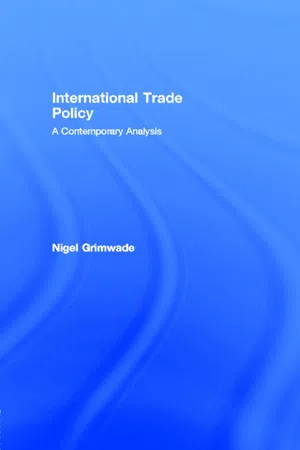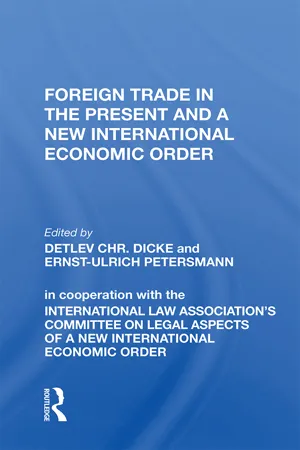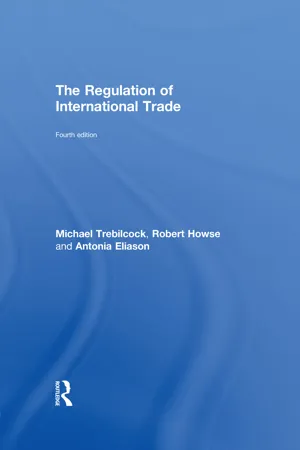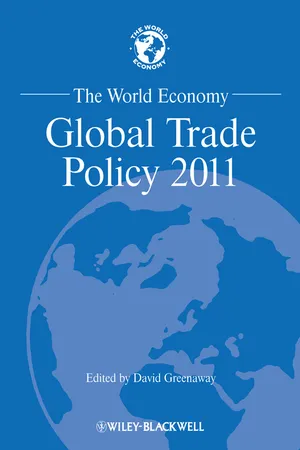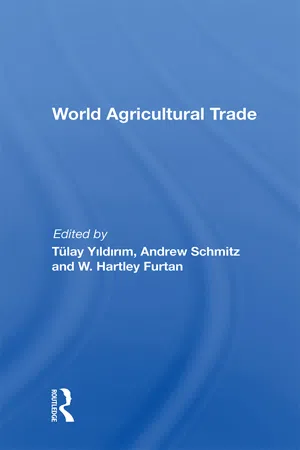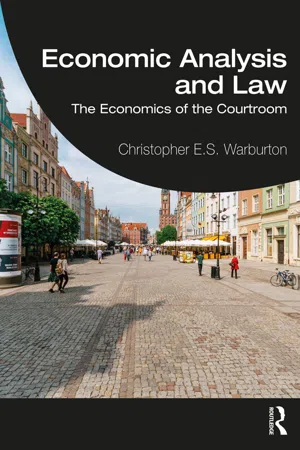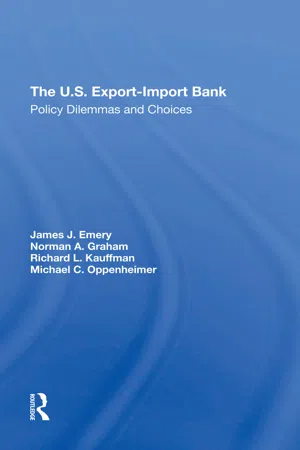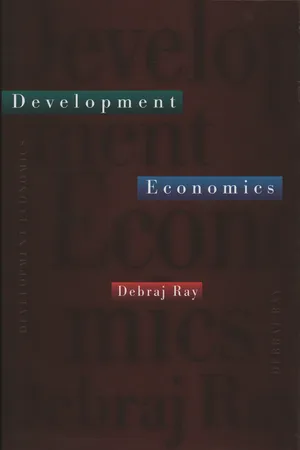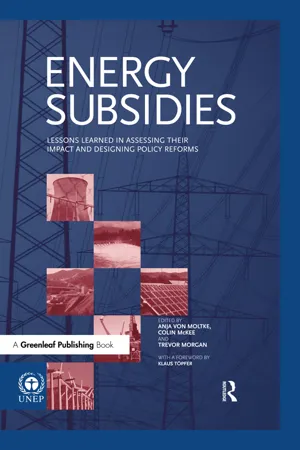Economics
Export Subsidy
An export subsidy is a financial incentive provided by a government to domestic companies to encourage them to export goods and services. This subsidy can take the form of direct payments, tax breaks, or other financial assistance. The goal is to make the country's exports more competitive in the global market by reducing the cost of production and increasing the volume of exports.
Written by Perlego with AI-assistance
Related key terms
12 Key excerpts on "Export Subsidy"
- eBook - ePub
International Trade Policy
A Contemporary Analysis
- Nigel Grimwade(Author)
- 2006(Publication Date)
- Routledge(Publisher)
domestic subsidy is paid to a producer on all that is produced regardless of whether the output is for export or the home market. In a manner similar to dumping, export subsidies allow an exporter to sell the good in a foreign market at a lower price than at home and possibly below costs of production. As with dumping, GATT rules deem such a practice to be ‘unfair’ if it causes or threatens material injury to producers in the importing country. Article VI allows countries to impose countervailing duties on such imports, provided that the rate of duty does not exceed the element of subsidy. As is explained later (p. 139), agricultural exports constitute an important exception to the rule.Export subsidies may be disguised in various ways. One form of this is the use of export credit subsidies whereby governments provide subsidised credit to foreign importers who purchase goods from the exporting country using loans taken out with a bank in the exporting country. In the past, such export credit subsidies have been the subject of a special ‘gentlemen’s agreement’ between OECD countries. The approach has been to agree limits on the amount of interest rate subsidy permissible for exports to different markets of the world. In other words, export credit subsidies have in the past not been regarded as a GATT issue.Domestic subsidies are in some respects a more complex issue since their purpose is often not a distortion of trade. In addition to financial aid granted to a particular producer or industry, they include total or partial tax exemption, remission of tax, provision of credit on special terms, and preferential treatment in the provision of public infrastructure. Although the primary intention may not be to restrict trade, either exports or imports may be indirectly affected. If the producer or industry which is subsidised exports part of its output, the subsidy will enable it to export at a lower price than would otherwise be possible. Foreign producers may therefore regard such a subsidy as a form of ‘unfair’ competition. Alternatively, if the producer or industry being subsidised sells all of its output domestically but is competing with imports from abroad, the subsidy may enable it to undercut foreign exporters. In this case, the effect is similar to a tariff in discriminating against foreign-produced goods. The GATT Treaty contained no provisions to control domestic subsidies. However, in recent decades, countries have become increasingly concerned about the trade-distorting effects of these measures. The concern was greatest in countries which adopted more laissez-faire policies. They argued that their producers were at an increasing disadvantage when competing with imports coming from countries where governments adopted more interventionist measures. There was a sense in which, as tariffs were gradually lowered, the impact of such measures on trade was more strongly felt. It may also have been the case that growing government intervention in industry in the 1960s and 1970s meant that subsidies played a more trade-distorting role than in earlier years. More recently, however, mounting deficits have caused governments to reduce the overall level of subsidies to industry, although more careful targeting of subsidies has been an accompanying factor (Ford and Suyker, 1989). Both export and domestic subsidies were the subject of a new Subsidies Code agreed in 1979 as part of the Tokyo Round. Its significance was that, unlike the GATT Treaty itself, it included domestic as well as export subsidies. Moreover, it went much further than the GATT Treaty in elaborating and interpreting the GATT provisions. A major deficiency of the Code was the failure to include agricultural subsidies, which have subsequently become a major source of trade-distortion (see Chapter 6 - eBook - ePub
Handbook of International Food and Agricultural Policies
(In 3 Volumes)Volume 1: Policies for Agricultural Markets and Rural Economic ActivityVolume 2: Policies for Food Safety and Quality, Improved Nutrition, and Food SecurityVolume 3: International Trade Rules for Food and Agricultural Products
- William H Meyers, Thomas Johnson, Donna H Roberts, Karl Meilke(Authors)
- 2017(Publication Date)
- WSPC(Publisher)
While conceptually an export tax is simply a negative subsidy, the disciplines that the WTO applies with respect to these two trade policy instruments are quite different. WTO Members place a high priority on containing and eliminating the use of export subsidies. In contrast, WTO rules do not discipline its Members’ application of export taxes even though this is the instrument that relates directly to the exercise of market power in export markets (Lloyd, 2005). In fact, about one-third of WTO Members impose export duties (Piermartini, 2004).Export subsidies and taxes are both border measures that are conditional upon the product being exported and the agent exporting the product either being subsidized or taxed. Traditionally, more policy and academic attention has been paid to export subsidies than to export taxes. However, Croser and Anderson (2011) show that, for the period 2000–2004, export taxes and subsidies contributed almost equally to global agricultural trade distortions. Furthermore, over the 1981–1984 period, Croser and Anderson (2011) demonstrated that on a global basis export taxes were seven times more trade-distorting than export subsidies. The reliance on export taxes was reflective of inward looking development policies where developing countries taxed agriculture to promote industrial development (Anderson, 2017). Moreover, a series of commodity price surges beginning in 2007/2008 re-focused concerns about the role that export restrictions played in exacerbating price surges.The WTO takes a broad view of the definition of a subsidy as “a financial contribution by a government or any public body within the territory of a Member that confers a benefit” (WTO, 1999). Given this very broad definition, an Export Subsidy can include direct payments, the granting of tax relief, the granting of low-interest loans, disposal of government stocks at below-market prices, subsidies financed by producers or processors as a result of government actions, marketing subsidies, transportation and freight subsidies, and subsidies for commodities contingent on their incorporation in exported products (ERS, 2003). Despite a WTO prohibition on subsidies that are contingent on export performance (WTO, 1994a, Article 3), these subsidies until very recently persisted in markets for agricultural products and capital goods. Agricultural export subsidies got special attention in the WTO because until now there was no outright prohibition on these subsidies although the Agreement on Agriculture put limits on existing export subsidies and prohibited the use of new export subsidies. - Detlev CHR. Dicke(Author)
- 2019(Publication Date)
- Routledge(Publisher)
II. Subsidies - a Disputed Tool of Economic Policy
Model approaches of market oriented economic theories show9 that subsidies are interventions with the mechanism of free adjustment of the allocation of resources in an economy by the play of market prices. They may direct resources into non-competitive sectors of production thus producing tosses of welfare. The signals of the markets will often be received less clearly if subsidies distort the mechanisms of reaction.Subsidies are an administrative (re-)distribution of national wealth. Subsidies in the sense of the word used here are paid by the state. The money for subsidies often has to be levied by taxes. Thus, the general public pays for the subsidized branch. Subsidies in foreign countries of exported goods are beneficial for foreign competitors and the domestic consumer, but they may be detrimental to domestic competitors and foreign consumers. In this case, there are flows of redistribution across the borderlines.Subsidies often lack transparency as to who pays the real cost.10 Since they are subject to the political powerplay of interest groups, there is a tendency for them to be perpetuated once they are granted, for no government wants to drive away voters. Thus, even subsidies that are justified at a given moment may become counterproductive after a while. The danger is that a government is not willing to phase them out if the time has come to do so.Distribution of wealth is a well known concern of national economic policy in all states. In a liberalized international trade setting, there may be some good reason for administrative interference with distribution. The free flow of goods itself causes a change in income distribution. International welfare and national welfare are better off if trade is as liberal as possible, but only in a Pareto - optimal sense. Some sectors inside a national economy may be much worse off. Social considerations, but also political goals like national security and the preservation of a minimum of domestic production in the food or energy sectors may be valid considerations for accepting a loss of economic welfare and redistribution of income. This is the result of a balancing between economic and other concerns of general national policy and it cannot be evaluated in terms of mere economic theory. The question remains: who decides on deliberate losses and income transfers?- eBook - ePub
- Leslie A White(Author)
- 2016(Publication Date)
- Routledge(Publisher)
We have reviewed the efforts of the Federal Government of the United States to curb the growth and power of great corporations, on the one hand, and to encourage and support small business enterprise on the other. We now turn to another area of governmental interference in the free enterprise system, namely subsidies.The term subsidy, as it is generally used, refers to assistance, financial or otherwise, rendered an industry by government without equivalent recompense. The assistance may consist of outright payments of money. But tax concessions, price supports, import quotas and other forms of protection against competition, low interest loans, provision of goods and services gratuitously or at less than cost, etc., are commonly regarded as subsidies.Subsidies may be direct or indirect, visible or concealed. In an earlier chapter we noted subsidies paid to grow mulberry trees to feed silk worms; payment was direct and obvious. Airlines and shipping companies have received concealed subsidies by being paid more than cost for transporting the mails. Also, within the Post Office Department, some classes of mail, e.g., magazines of private publishers, are carried at less than cost, while other classes may more than pay their way. The petroleum industry in the United States has been subsidized by “percentage depletion and permission to charge off the bulk of new exploration costs as current expense … [enabling] oil producers to avoid income taxes and accumulate great fortunes” (Bassie, 1968, p. 366). Subsidies increased as tax rates were raised; and when profits were threatened by foreign competition, oil “producer pressures induced the government to establish import quotas—a secondary subsidy to protect the values already established” (Bassie, 1968, p. 366). There has been considerable debate as to whether or not the use of public highways by trucking companies and bus lines in competition with railroads, constitutes a form of subsidy (see Subsidy and Subsidy-Effect Programs - eBook - ePub
The Regulation of International Trade
4th Edition
- Robert Howse, Antonia Eliason(Authors)
- 2013(Publication Date)
- Routledge(Publisher)
283 While we recognize the broader international risk of Prisoner’s Dilemma-type Export Subsidy wars, negotiated reductions of, or restrictions on, such subsidies in given contexts, as reflected in the Uruguay Round Agreement on Agriculture, the Tokyo Round Code on Trade in Civil Aircraft, and the OECD Agreement on Civil Shipbuilding and Repair, seem an appropriate response to this problem. We also recognize that pure export subsidies will typically be harder to justify in terms of non-trade-related domestic policy objectives, most of which can be better served by subsidies or other policy instruments that are not targeted exclusively on exports, but again it is not clear why this should be of concern to the importing country.Similarly, generally available subsidies under the Uruguay Round Agreement are not seen as trade distorting with respect to either imports or exports, presumably because they do not disproportionately influence the price of particular categories of goods. However, this view reflects a rather static conception of comparative advantage; most modern international trade theorists believe comparative advantage is a dynamic concept and is not entirely exogenously determined.284 Clearly, many developed countries owe a significant part of their international comparative advantage to social investments in health, education, law and order, basic research, and physical infrastructure. It may be the case that generally available subsidies are more benign than selective subsidies because they are less likely to be the product of rent seeking by special interest groups. It may also be the case that generally available subsidies are reflected more fully in exchange rate adjustments than selective or targeted subsidies. However, in an international environment, where exchange rates are determined increasingly by international capital flows rather than goods flows, it is not clear how robust this assumption is, or when one can be confident that generally available subsidies have induced appropriate exchange rate adjustments while more selective subsidies have not.Finally, there remain selective domestic subsidies with export spillovers. In this case, the economic analysis is the same as that for the case of pure export subsidies: the importing country receives lower-priced goods and increases its welfare. To the extent that such subsidies squeeze out a third-country’s exports, then the third country should, as in the case of pure export subsidies, have a right to bring a nullification and impairment claim before a GATT dispute resolution panel. - eBook - ePub
Global Trade Policy
Questions and Answers
- Pamela J. Smith(Author)
- 2013(Publication Date)
- Wiley-Blackwell(Publisher)
That is, the country is already an exporter of the good prior to the subsidy policy. In these cases, the subsidy serves to increase the volume of the exports above the free trade levels. In reality, we cannot observe whether a country has a comparative advantage or disadvantage in the absence of subsidies. However, the adoption of a protectionist policy (such as export subsidies) suggests that in the absence of the policy, the country would have difficulty competing with lower priced goods in the international market. Thus, we considered a fourth case where a large country with a comparative disadvantage adopts an Export Subsidy. The results of this case mirror those of the previous cases. The primary difference is that the home country is an importer prior to the policy and an exporter after the policy. Similarly, the foreign country is an exporter prior to the policy and an importer after the policy. Furthermore, in this case it is possible for both the importer and exporter to be adversely affected by the Export Subsidy which reverses the patterns of trade. How is the burden of the Export Subsidy allocated across countries and agents? The price effect of the subsidy is allocated in different ways across countries in the cases above. The price effects of the subsidy are shared between the exporter and importer when the elasticities of export supply and import demand are relatively similar. This corresponds with the large exporter who can affect the world price, but faces an importer who is similarly price responsive (i.e., Case 1). However, even when the price effects are shared, the welfare effects are not shared equally. The welfare effects are unambiguously negative for the exporter and are positive for the importer. In contrast, the price effects of the subsidy are experienced entirely by the exporter when the exporter faces an infinitely elastic import demand - eBook - ePub
The World Economy
Global Trade Policy 2011
- David Greenaway, David Greenaway(Authors)
- 2012(Publication Date)
- Wiley-Blackwell(Publisher)
2The northeast Asian developing economies, for instance, were able to pursue active export promotion especially until the 1980s. The measures taken comprised tax incentives (Falvey and Gemmell, 1990), duty drawback (Wade, 1991), export credit/insurance (Mah and Milner, 2005), provision of export processing zones (EPZs) or special economic zones (Warr, 1990; Mah, 2008), devaluation or depreciation of domestic currency and establishment of export promotion organisations providing trade marketing, information and assisting trade fair (Seringhaus and Rosson, 1990). Until the early 1990s, developing countries were relatively free from trade regulations in the global trading system prohibiting the use of export promotion measures. Meanwhile, as of now, there are many restrictions or even strict prohibition on the developing countries’ use of export promotion policies under the WTO system. Considering the different levels of economic development between developed and developing countries, one may wonder whether or not the current WTO system, which strictly regulates the use of export promotion policies by developing countries, is ‘fair’.This paper explains the export promotion measures that can be utilised by developing countries under the current WTO system and compares the WTO Members’ proposals on modification of export promotion provisions in the Doha Development Agenda (DDA) negotiations. Then, from the viewpoint of ‘distributional fairness’, it suggests ways of modifying the special and differential treatment (SDT) provisions applied to exports of developing economies in the Agreement on Subsidies and Countervailing Measures, the Subsidies Code hereafter, of the WTO. Despite the importance of export promotion in economic development, there has been little, if any, work focusing on the SDT of developing countries with respect to export promotion policies in the WTO system. This paper is intended to fill that gap. - eBook - ePub
- Andrew Schmitz(Author)
- 2019(Publication Date)
- Routledge(Publisher)
An important difference between the export-subsidy policy and the marketing-board policy is the source of funds that are transferred to producers. This implies important differences in the incidence of costs and benefits of producer-price support between the policies. The Export Subsidy involves taxpayers' funds and, if these funds were to have a large enough marginal excess burden, the Export Subsidy could be a less efficient way of supporting producers. If the deadweight losses from general taxation were absent, the Export Subsidy would clearly be more efficient than the marketing board. If a marketing board were to achieve the same benefit for producers, it would have to raise revenue from its consumers.When price discrimination among foreign markets is not possible, and domestic demand is less elastic than foreign demand, the marketing board will tax domestic consumers more heavily so that exports will be subsidized at a greater rate, on average, compared with the explicit Export Subsidy. In turn, the burden on third-country exporters is greater from the marketing board than from the pure-Export Subsidy Relative to the marketing board, the transfer efficiency of export subsidies could be higher or lower in terms of benefits to producers per dollar of harm to domestic consumers and taxpayers, but it could not be lower in terms of benefits to producers per dollar of harm to third countries. At first, this new result seems somewhat surprising but, on closer examination, the countries with wheat-marketing boards (Australia, Canada and, in the past, Argentina) have tended to offer lower rates of producer protection than the countries that used explicit export subsidies (notably the United States and the European Union). This may have masked the fact that, for a given rate of protection to producers, the marketing board required a higher effective rate of Export Subsidy.Generally, when price discrimination among international markets is possible, the effects are more ambiguous. The extent to which domestic price discrimination can be used to achieve a particular support level is a function of the relative elasticities and the size of the various markets. It was shown in our simulation results that, compared with targeted export subsidies (and even more so compared with flat export subsidies), the CWB is a more efficient mechanism for supporting Canadian wheat producers. - eBook - ePub
Economic Analysis and Law
The Economics of the Courtroom
- Christopher E.S. Warburton(Author)
- 2020(Publication Date)
- Routledge(Publisher)
45While multiple negotiations between the US and the EC were conducted in the 1990s, the concept of subsidy was multilaterally imprecise until one was provided by the SCM Agreement during the Uruguay Round of talks:A subsidy exists where―there is a financial contribution by a government, and―a benefit is thereby conferred. Financial contribution is broadly construed as meaning―money or anything else of value provided to a manufacturer or exporter at a cost less than would have been charged in a commercial transaction. This includes measures such as exchange rate guarantees, debt forgiveness, export credits, and equity infusions, and any capital or development supports provided on terms more favorable than terms available from commercial lenders. In addition, this can also include indirect support such as benefits from government or defense contracts.(Kienstra, 2012, p. 583)Newer agreements meant newer negotiating framework and contending reference points, which further complicated negotiations. While the Uruguay Round, as it was signed on December 15, 1994, did not include a new agreement on civil aircraft, the SCM Agreement and the DSU included the LCA industry.In the SCM Agreement, subsidies fall into three broad classifications: (i) permissible, (ii) actionable, and (iii) prohibited; the so-called “green, yellow, and red lights.” Contingent subsidies (in law or fact) are prohibited subsidies. Prohibited subsidies are based on prospective export performance and are intended to give firms a competitive edge while also increasing their revenue base. Actionable (specific) subsidies cause adverse effects on free trade (see Figure 8.8 Panel (b)). Specific subsidies are injurious; they cause nullification and create serious prejudice to the interests of other Members. Serious prejudice occurs when a subsidy displaces or impedes imports into the subsidizing country or a third country market. The subsidy must also cause significant price undercutting, suppression, depression, or increase the world market share of the subsidizing country that causes loss to others.46 - eBook - ePub
The U.s. Exportimport Bank
Policy Dilemmas And Choices
- James J. Emery, Michael F Oppenheimer, Norman A Graham, Richard L Kauffman(Authors)
- 2019(Publication Date)
- Routledge(Publisher)
Eximbank finance is an important factor in support of high-technology exports because of the use of credit subsidies by competitors to support their high-technology industries. The Bank's role is in offsetting these credit subsidies, as in other industries. The Bank would be an inefficient means of attempting to offset the effects of extensive government support of high-technology industries by other industrial nations. If additional government intervention is necessary in this regard it would be better directed at the source of technological advancement through greater incentives for innovation and increasing research and development effort.Government Intervention in Support of Exports
As the preceding discussion of high-technology industries illustrates, U.S. capital goods producers are often faced with competition from foreign industries that receive extensive governmental backing. Where government support takes the form of outright subsidy (except export credits), overly restrictive government procurement preferences, and other blatantly protectionist means, some form of remedy is generally available through provisions of the U.S. Trade Acts or the MTN codes. However, government support often takes less tangible or easily countered forms. A particular problem U.S. firms face from European industry is that of competition from state-owned enterprises. This is especially true in aircraft and aircraft engines, nuclear power, and telecommunications. State-owned enterprises are typically not under the same type of pressure to produce continual profits as is private industry in the United States, and typically respond more to the goals of increasing production and employment. They are in many cases more willing to take loss-leading ventures into new markets than their U.S. counterparts are.While state-owned firms typically enjoy a variety of government supports, they also share these with private firms that are the favored targets of industrial policies. The use of negotiating leverage by high-level government officials and a willingness to introduce diplomatic concessions into commercial negotiations are perhaps the most distortive of these measures. One example of the extreme use of these types of linkages was the tying of aircraft sales to the granting of reciprocal landing rights. The recognition of the distortive effects of these practices led to the civil aircraft agreement concluded in the Tokyo Round of multilateral trade negotiations. In general, the United States has been more reticent than competitors to utilize such means of export promotion. For example, high-level visits by U.S. officials to foreign countries are rarely accompanied by commercial representatives of U.S. firms, which is a standard practice of other industrial nations. - eBook - ePub
- Debraj Ray(Author)
- 1998(Publication Date)
- Princeton University Press(Publisher)
Thus both import substitution and (effective) export promotion policies tend to create an appreciation in the exchange rate of the country carrying out such policies. Intuitively, this should be quite obvious. Import substitution restricts the demand for dollars, while (successful) export promotion expands the supply of dollars. Thus in both cases, there is a tendency for the equilibrium price of dollars to fall, all other things being equal.Figure 17.10. Equilibrium exchange rates under export promotion .However, the similarity ends here, because all other things are not equal. Think of a government engaged in import substitution. For such a government, an overvaluation of the exchange rate (relative to the market outcome) may be ignored or even welcome. Some sectors are protected at prohibitive levels from “unwelcome” imports, and although the appreciation of the exchange rate makes such imports appear more attractive (at market prices), these attractions can be countered by use of tariffs and quotas. In addition, those imports that are deemed necessary can be obtained at cheaper international prices (i.e., less pesos have to be forsaken per dollar to obtain such imports). The appreciation in the exchange rate harms exports , but governments intent on target practice in their home markets may not particularly care or bother.Contrast this with the export-promoting government. Exports are their main concern and an appreciation of the exchange rate hurts this objective. It is therefore not surprising that export promotion often goes hand in hand with attempts to keep the exchange rate low by other means, such as (surprise) devaluations of the currency, followed by appropriate monetary policy.17.3.3. The instruments of export promotion: More detail
The Export Subsidy
Let’s begin by studying an Export Subsidy, which essentially works as the opposite number of an import tariff. Consult Figure 17.11 , which depicts the domestic demand and supply curves for some product. Initially, the international price of the product is at p *. You can read off various observations from the diagram. Domestic sales, initially, must be given by the amount OA (because any lower level of sales would be met by a higher price than the international price, and any higher level would sell only domestically at a price lower than the international price). The remaining supply at that price (all the way up to the supply curve) is exported. This is the quantity AB - eBook - ePub
Energy Subsidies
Lessons Learned in Assessing their Impact and Designing Policy Reforms
- Anja von Moltke, Colin McKee, Trevor Morgan, Klaus Töpfer(Authors)
- 2017(Publication Date)
- Routledge(Publisher)
Direct subsidies, in the form of grants or tax exemptions, act as a drain on government finances. For example, the IMF estimates that the Iranian government’s direct spending on energy subsidies amounted to $4 billion in 1997—8% of its budget. The cost of oil product subsidies in Indonesia is even higher, at around 10% of central government spending. The special low rate of VAT that was applied to the sale of electricity and gas to households by the Czech and Slovak governments in the 1990s exacerbated those countries’ budget deficit problems. Direct subsidies on oil products can lead to acute pressure on government finances during periods of rising prices. This has been a major problem in several developing countries, including Indonesia. Indonesia allocated almost $4 billion to oil subsidies in 2002. If left unchanged, the bill for those subsidies would soar to around $36 billion between 2000 and 2005 due to higher oil prices. In the long run, indirect subsidies that reduce economic growth also lead to lower government tax revenues.Subsidies always have an impact on international trade. Consumption subsidies that increase energy use boost demand for imports or reduce the amount of energy available for export. This harms the balance of payments by increasing the country’s dependence on imports. For example, the massive increase in LPG use in Senegal that resulted largely from subsidies has led to a huge increase in imports. The Indonesian government estimates that energy subsidies in total will cost the country $16 billion in lost export earnings over the five years to 2005 if they are left as they are. Iran’s exports of crude oil will decline rapidly if subsidies are not removed soon, since production will be unable to keep pace with soaring domestic consumption. Subsidies in major energy-producing countries such as Indonesia and Iran also undermine global energy security to the extent that they reduce those countries’ capacity to export. The removal of subsidies to oil products would lower domestic demand in Indonesia and free up more oil for export, thereby reducing the share of the dominant OPEC countries in international oil trade and reducing those countries’ ability to push for higher prices.
Index pages curate the most relevant extracts from our library of academic textbooks. They’ve been created using an in-house natural language model (NLM), each adding context and meaning to key research topics.
